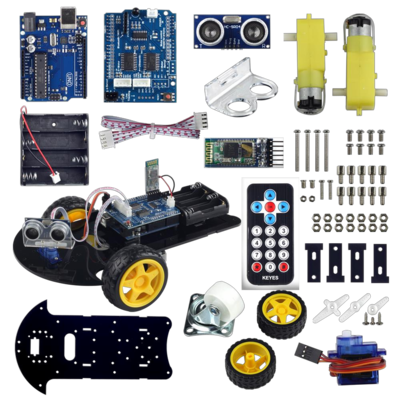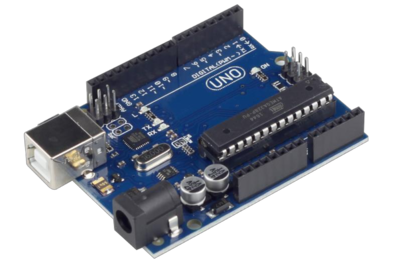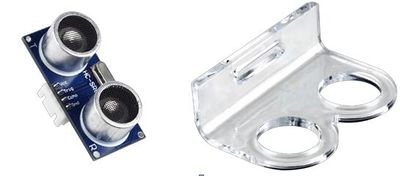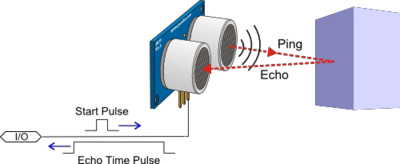Smart-Robot-Car-Arduino
Model: K0070
Contents
Introduction
The UCTRONICS Smart Bluetooth Robot Car Kit is a flexible vehicular kit particularly designed for education, competition and entertainment. The kit has an intelligence built in so that it guides itself whenever an obstacle comes ahead of it. An Arduino development is used to achieve the desired operation. With the help of a small servo motor, it scans the area left and right in order to find the best way to turn. An ultrasonic sensor unit is used to detect any obstacle ahead of it that sends a command to the Arduino Board. Depending on the input signal received, the Arduino microcontroller redirects the robot to move in an alternate direction by appropriately actuating the motors interfaced to it through a motor driver IC. When all the necessary components are getting together, a robot car comes up!
A robot is a machine that can perform some task automatically or with guidance. Robotics is generally a combination of computational intelligence and physical machines (motors). Due to their high level of performance and reliability, the robot gets the splendid popularity in our daily life. Come up; let’s go into a Robot World!
Packing list
- 1pcs UNO R3 Board for Arduino
- 1pcs HC-SR04 Ultrasonic Sensor Module
- 1pcs Holder for HC-SR04
- 1pcs L293D Motor Drive Expansion Board
- 1pcs 9g micro servo motor
- 1pcs Infrared IR Wireless Remote Control Sensor Module Kits
- 1pcs HC-05 Bluetooth Serial transmission Wireless Module
- 1pcs cable
- 1set Car Chassis Kits:
- 2pcs 65mm tire Wheels
- 2pcs Geared Motors (1:48)
- 1pcs Universal Wheel
- 1pcs Battery Container
- 1pcs Car Chassis
- Screws+ Nuts
Parts Introduction
This is the new Uno R3 board for Arduino. In addition to all the features of the previous board, the Uno now uses an ATmega 16U2 instead of the 8U2 found on the Uno (or the FTDI found on previous generations). This allows for faster transfer rates and more memory. No drivers needed for Linux or Mac (.inf file for Windows is needed and included in the Arduino IDE), and the ability to have the Uno show up as a keyboard, mouse, joystick, etc. The Uno R3 also adds SDA and SCL pins next to the AREF. In addition, there are two new pins placed near the RESET pin. One is the IOREF that allow the shields to adapt to the voltage provided from the board. The other is a not connected and is reserved for future purposes. The Uno R3 works with all existing shields but can adapt to new shields which use these additional pins. Note: The Uno R3 requires the Arduino 1.0 drivers folder in order to install properly on some computers. We have tested and confirmed that the R3 can be programmed in older versions of the IDE. However, the first time using the R3 on a new computer, you will need to have Arduino 1.0 installed on that machine. If you are interested in reading more about the changes to the IDE, check out the official Arduino 1.0 Release notes!
Specifications
| Microcontroller: ATmega328P | Operating Voltage: 5V |
| Input Voltage (recommended): 7V-12V | Input Voltage (limits): 6V-20V |
| Digital I/O Pins: 14 (of which 6 provide PWM output) | Analog Input Pins: 6 |
| DC Current per I/O Pin: 40 mA | DC Current for 3.3V Pin: 50 mA |
| Flash Memory: 32 KB (ATmega328) of which 0.5 KB used by bootloader | SRAM: 2 KB (ATmega328) |
| EEPROM: 1 KB (ATmega328) | Clock Speed: 16 MHz |
HC-SR04 Ultrasonic Sensor Module with Bracket / Holder
The HC-SR04 ultrasonic sensor module for Arduino is used for obstacle detection. Ultrasonic sensor transmits the ultrasonic waves from its sensor head and again receives the ultrasonic waves reflected from an object.
Ultrasonic sensor general diagram
Working Principle
The ultrasonic sensor emits the short and high frequency signal. These propagate in the air at the velocity of sound. If they hit any object, then they reflect back echo signal to the sensor. The ultrasonic sensor consists of a multi vibrator, fixed to the base. The multi vibrator is combination of a resonator and vibrator. The resonator delivers ultrasonic wave generated by the vibration. The ultrasonic sensor actually consists of two parts; the emitter which produces a 40 kHz sound wave and the detector detects 40 kHz sound wave and sends electrical signal back to the microcontroller.
Ultrasonic working principle. The ultrasonic sensor enables the robot to virtually see and recognize object, avoid obstacles, measure distance. The operating range of ultrasonic sensor is 2 cm to 450 cm




